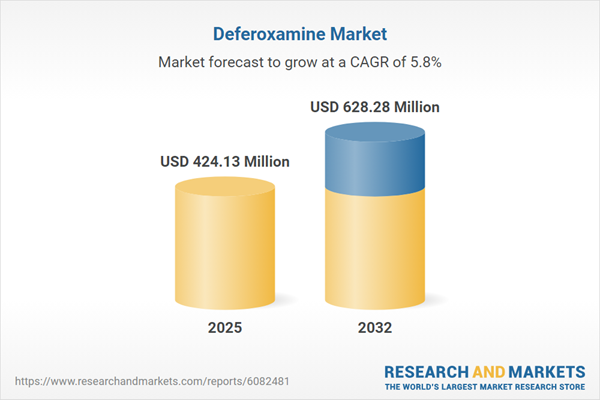Speak directly to the analyst to clarify any post sales queries you may have.
The deferoxamine market is rapidly progressing, shaped by technological innovation, a stronger focus on patient-centered care, and evolving stakeholder requirements. Senior decision-makers are seeking data-driven insights to guide effective strategies in this dynamic landscape and harness new opportunities quickly.
Market Snapshot: Deferoxamine Market Size and Growth
The global deferoxamine market reached USD 401.41 million in 2024, with continued expansion to USD 424.13 million anticipated by 2025. Analysts forecast a compound annual growth rate of 5.75%, projecting the market to attain USD 628.28 million by 2032. This growth stems from increasing demand for iron chelation therapies, advances in targeted therapeutic areas, and a shift toward patient-centric healthcare models. Decision-makers are prioritizing scalable solutions and innovation amidst intensifying sector competition and changing regulatory frameworks.
Scope & Segmentation of the Deferoxamine Market
- Indication: Sideroblastic Anemia and Thalassemia, including both Non Transfusion Dependent and Transfusion Dependent forms, remain central to deferoxamine’s clinical application, driving therapy adoption and research.
- Route Of Administration: Intravenous and Subcutaneous pathways provide flexibility for diverse patient profiles, optimizing adherence and enabling effective use across treatment settings.
- End User: Home Healthcare Settings (Private Home Care, Skilled Nursing Facilities), Hospitals (Government, Private), and Specialty Clinics (Hematology, Thalassemia Clinics) each present unique therapy and access needs, shaping product distribution and support strategies.
- Distribution Channel: Distribution Partners, Hospital Pharmacies, Online Pharmacies (via Aggregator and Branded Platforms), and Retail Pharmacies (Chain, Independent) offer an omni-channel approach, broadening patient access and streamlining supply.
- Payer Type: Government Insurance (Medicaid, Medicare), Private Insurance (Commercial, Employer Sponsored), and Self Pay each affect reimbursement dynamics and therapy uptake in distinct ways.
- Regions: Americas (United States, Canada, Mexico, Brazil, Argentina, Chile, Colombia, Peru), Europe, Middle East & Africa (United Kingdom, Germany, France, Russia, Italy, Spain, and more), and Asia-Pacific (China, India, Japan, Australia, South Korea, Indonesia, Thailand, Malaysia, Singapore, Taiwan) each pose unique access, regulatory, and demographic considerations that must be addressed to ensure broad therapy uptake and compliance.
- Key Companies: Novartis AG, Teva Pharmaceutical Industries Ltd, Sandoz International GmbH, Viatris Inc, Sun Pharmaceutical Industries Ltd, Cipla Ltd, Apotex Inc, Jubilant Life Sciences Ltd, Fresenius Kabi AG, Baxter International Inc drive strategy, supply, and commercial initiatives worldwide.
Key Takeaways: Strategic Deferoxamine Market Insights
- Growth in clinical applications is broadening deferoxamine’s use for hereditary anemia and transfusion-related conditions, enhancing long-term opportunity for market participants.
- Advances in delivery technology, such as subcutaneous infusion pumps and extended-release formulations, are improving adherence and therapy comfort, balancing efficacy with patient experience.
- Emergence of precision medicine is fueling adoption of individualized dosing approaches, supported by digital monitoring and integration within leading care systems.
- Adaptive, region-specific market-entry strategies are helping organizations navigate disparate regulations, local infrastructure challenges, and distinct payer requirements.
- Supply chain dynamics are evolving through strategic partnerships among manufacturers, contract development entities, and digital distribution partners, optimizing access and coverage.
Tariff Impact: United States Supply Chain Dynamics
Recent tariff adjustments in the United States are introducing added operational and cost pressures on deferoxamine supply chains. Increased duties on imported pharmaceutical ingredients and infusion components are prompting manufacturers to revise sourcing strategies, strengthen domestic production, and adjust inventory management. These market shifts underline the need for robust forecasting, enhanced safety stock controls, and stronger collaborations with both payers and policy bodies to protect therapy continuity and access.
Methodology & Data Sources
This report is informed by comprehensive primary research involving interviews with hematologists, pharmacology experts, administrators, and payer representatives. These insights are augmented with secondary research, including regulatory analysis and detailed market modeling. Cross-functional workshops have been used to support data validation and ensure actionable, sector-specific recommendations.
Why This Report Matters: Value for Senior Decision-Makers
- Presents a clear analysis of deferoxamine market drivers, segmentation, and technology trends, enabling targeted strategy formulation and improved market positioning.
- Offers definitive insights into supply chain risks and shifting regulatory factors, equipping leaders to develop proactive risk mitigation plans and strengthen operational resilience.
- Supports the identification of emerging commercialization opportunities and patient access challenges in an evolving global market environment.
Conclusion
The deferoxamine market is continuously shaped by advancements in therapy, regulatory changes, and shifts in demand. Leveraging robust insights will enable organizations to align development priorities, streamline commercial strategies, and improve patient access in a complex global environment.
Table of Contents
3. Executive Summary
4. Market Overview
7. Cumulative Impact of Artificial Intelligence 2025
Companies Mentioned
The companies profiled in this Deferoxamine market report include:- Novartis AG
- Teva Pharmaceutical Industries Ltd
- Sandoz International GmbH
- Viatris Inc
- Sun Pharmaceutical Industries Ltd
- Cipla Ltd
- Apotex Inc
- Jubilant Life Sciences Ltd
- Fresenius Kabi AG
- Baxter International Inc
Table Information
| Report Attribute | Details |
|---|---|
| No. of Pages | 197 |
| Published | October 2025 |
| Forecast Period | 2025 - 2032 |
| Estimated Market Value ( USD | $ 424.13 Million |
| Forecasted Market Value ( USD | $ 628.28 Million |
| Compound Annual Growth Rate | 5.7% |
| Regions Covered | Global |
| No. of Companies Mentioned | 11 |









